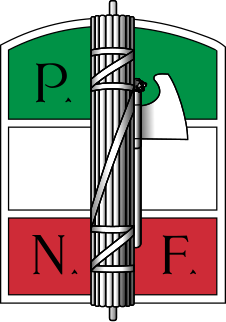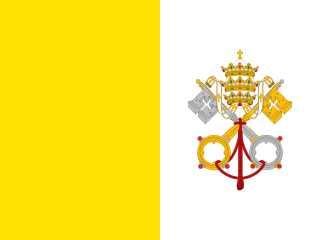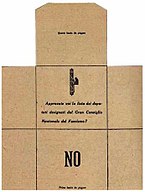
Pope Pius XI, born Ambrogio Damiano Achille Ratti, was head of the Catholic Church from 6 February 1922 to his death in 1939. He was the first sovereign of Vatican City from its creation as an independent state on 11 February 1929. He took as his papal motto, "Pax Christi in Regno Christi," translated "The Peace of Christ in the Kingdom of Christ."

Giacomo Matteotti was an Italian socialist politician. On 30 May 1924, he openly spoke in the Italian Parliament alleging the Fascists committed fraud in the recently held elections, and denounced the violence they used to gain votes. Eleven days later he was kidnapped and killed by Fascists.
Fernando Mezzasoma was an Italian fascist journalist and political figure.
Clerical fascism is an ideology that combines the political and economic doctrines of fascism with clericalism. The term has been used to describe organizations and movements that combine religious elements with fascism, support by religious organizations for fascism, or fascist regimes in which clergy play a leading role.

The March on Rome was an organized mass demonstration in October 1922, which resulted in Benito Mussolini's National Fascist Party ascending to power in the Kingdom of Italy. In late October 1922, Fascist Party leaders planned an insurrection, to take place on 28 October. When fascist troops entered Rome, Prime Minister Luigi Facta wished to declare a state of siege, but this was overruled by King Victor Emmanuel III. On the following day, 29 October 1922, the King appointed Mussolini as Prime Minister, thereby transferring political power to the fascists without armed conflict.

Michele Bianchi was an Italian revolutionary syndicalist leader who took a position in the Unione Italiana del Lavoro (UIL) He was among the founding members of the Fascist movement. He was widely seen as the dominant leader of the leftist, syndicalist wing of the National Fascist Party. He took an active role in the "interventionist left" where he "espoused an alliance between nationalism and syndicalism." He was one of the most influential politicians of the regime before his succumbing to tuberculosis in 1930. He as well was one of the grand architects behind the "Great List" which secured the parliamentary majority in favor of the fascists.

Roberto Farinacci was a leading Italian Fascist politician, and important member of the National Fascist Party (PNF) before and during World War II, and one of its ardent anti-Semitic proponents; Christopher Hibbert describes him as "slavishly pro-German".

Giacomo Acerbo, Baron of Aterno was an Italian economist and Fascist politician who drafted the Acerbo Law which solidified Benito Mussolini's position once in power.

Giovanni Giuriati was an Italian fascist politician.
Edoardo Alfieri was an Italian fascist politician and diplomat.

Italian Fascism, also known as Classical Fascism or simply Fascism, is the original fascist ideology as developed in Italy. The ideology is associated with a series of three political parties led by Benito Mussolini, namely the Fascist Revolutionary Party (PFR) founded in 1915, the succeeding National Fascist Party (PNF) which was renamed at the Third Fascist Congress on 7–10 November 1921 and ruled the Kingdom of Italy from 1922 until 1943 and the Republican Fascist Party that ruled the Italian Social Republic from 1943 to 1945. Italian Fascism is also associated with the post-war Italian Social Movement and subsequent Italian neo-fascist movements.

The Kingdom of Italy was a state which existed from 1861—when King Victor Emmanuel II of Sardinia was proclaimed King of Italy—until 1946—when civil discontent led a constitutional referendum to abandon the monarchy and form the modern Italian Republic. The state was founded as a result of the unification of Italy under the influence of the Kingdom of Sardinia, which can be considered its legal predecessor state.

Fascism in Europe was composed of numerous ideologies present during the 20th century which all developed their own differences from each other. Fascism was born in Italy, but subsequently several movements across Europe which took influence from the Italian faction emerged. The first foundations of fascism can be seen in the Italian Regency of Carnaro, many of the politics and aesthetics were taken from Gabriele D'Annunzio's rule and subsequently used by Mussolini and his Italian Fasci of Combat which he founded five months prior in 1919. Despite members referring to themselves as "fascists" the ideology of fascism wouldn't fully develop until in 1921 when Mussolini transformed his movement into the National Fascist Party which then in 1923 incorporated the Italian Nationalist Association. The INA was a nationalist movement that established fascist tropes, colored shirt uniforms for example, and also received the support of important proto-fascists like D'Annunzio and Enrico Corradini.

Chamber of Fasci and Corporations was the lower house of the legislature of the Kingdom of Italy from March 23, 1939 to August 2, 1943, during the height of the regime of Benito Mussolini's National Fascist Party.
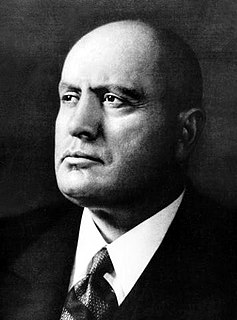
Benito Amilcare Andrea Mussolini was an Italian politician and journalist who was the leader of the National Fascist Party. He ruled Italy as Prime Minister from 1922 to 1943; he constitutionally led the country until 1925, when he dropped the pretense of democracy and established a dictatorship.
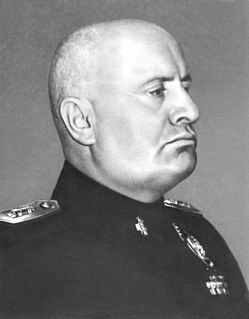
General elections were held in Italy on 24 March 1929. By this time, the country was a single-party state with the National Fascist Party (PNF) as the only legally permitted party.
Events from the year 1922 in Italy.

The Italian Parliament (1928–1939) was the parliament of Italy as it existed following the constitutional reforms enacted after the Italian general election, 1924. It was, in turn, substantially restructured in 1939. This early Fascist-era legislature was a continuation of the bicameral parliament that had existed prior to 1928, though the character, structure and responsibilities of each house were altered to various degrees.

Fascist Italy is the era of National Fascist Party government from 1922 to 1943 with Benito Mussolini as head of government of the Kingdom of Italy. The fascists imposed totalitarian rule and crushed political and intellectual opposition, while promoting economic modernization, traditional social values and a rapprochement with the Roman Catholic Church. According to Payne (1996), "[the] Fascist government passed through several relatively distinct phases". The first phase (1923–1925) was nominally a continuation of the parliamentary system, albeit with a "legally-organized executive dictatorship". Then came the second phase, "the construction of the Fascist dictatorship proper, from 1925 to 1929". The third phase, with less activism, was 1929 to 1934. The fourth phase, 1935–1940, was characterized by an aggressive foreign policy: war against Ethiopia, which was launched from Eritrea and Somaliland; confrontations with the League of Nations, leading to sanctions; growing economic autarky; and the signing of the Pact of Steel. The war itself (1940–1943) was the fifth phase with its disasters and defeats, while the rump Salò Government under German control was the final stage (1943–1945).


